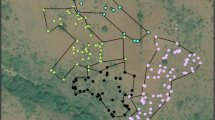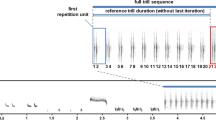Abstract
In many animal species, individuals compete for resources but avoid escalated conflicts by threat displays, i.e. a mutual signalling behaviour that enables the opponents to predict the outcome of the conflict without the necessity of actual fighting. For example, territory holders may use acoustic signals to communicate not only their own identity and the borders of their territory but also their competitive quality, fighting ability and motivation. Here, we show that male sac-winged bats, Saccopteryx bilineata, adjust their vocal territorial displays according to the fundamental frequency of territorial songs of their opponents. In playback experiments with territorial males, low-frequency stimuli elicited a higher territorial song rate and length than high-frequency stimuli. Male S. bilineata that sing more often and with lower fundamental frequencies have been shown to sire more offspring than their competitors. Fundamental frequency of territorial songs, hence, may reveal male quality and, consequently, the resulting threat posed to competing males. We argue that this is reflected in the increased response of competitors to low-frequency territorial songs shown here. Such competitive signalling behaviour has been shown in a few mammal species like red deer and baboons but, thus far, not in bats.




Similar content being viewed by others
References
Andersson M (1994) Sexual selection. Princeton University Press, Princeton
Bazley E (1976) Sound absorption in air at frequencies up to 100 kHz, vol. Ac74. National Physical Laboratory, Teddington
Behr O, von Helversen O (2004) Bat serenades-complex courtship songs of the sac-winged bat (Saccopteryx bilineata). Behav Ecol Sociobiol 56:106–115
Behr O, von Helversen O, Heckel G, Nagy M, Voigt CC, Mayer F (2006) Territorial songs indicate male quality in the sac-winged bat Saccopteryx bilineata (Chiroptera, Emballonuridae). Behav Ecol 17:810–817
Bradbury JW, Emmons LH (1974) Social organization of some Trinidad bats I Emballonuridae. Z Tierpsychol 36:137–183
Bradbury JW, Vehrencamp SL (1998) Principles of animal communication. Sinauer, Sunderland
Catchpole CK (1983) Variation in the song of the great reed warbler Acrocephalus arundinaceus in relation to mate attraction and territorial defence. Anim Behav 31:1217–1225
Catchpole CK (1987) Bird song, sexual selection and female choice. Trends Ecol Evol 2:94–97
Christie PJ, Mennill DJ, Ratcliffe LM (2004) Pitch shifts and song structure indicate male quality in the dawn chorus ob black-capped chickadees. Behav Ecol Sociobiol 55:341–348
Clutton-Brock TH, Albon SD (1979) The roaring of red deer and the evolution of honest advertisement. Behaviour 69:145–170
Clutton-Brock TH, Guinness FE, Albon SD (1982) Red deer. Behaviour and ecology of two sexes. Edinburgh University Press, Edinburgh
Collins S (2004) Vocal fighting and flirting: the functions of birdsong. In: Marler P, Slabbekoorn H (eds) Nature’s music—the science of birdsong. Elsevier Academic, San Diego, pp 39–78
Cramer ERA, Price JJ (2007) Red-winged blackbirds Agelaius phoeniceus respond differently to song types with different performance levels. J Avian Biol 38:122–127
Dabelsteen T, Pedersen SB (1990) Song and information about aggressive responses of blackbirds, Turdus merula: evidence from interactive playback experiments with territory owners. Anim Behav 40:1158–1168
Davidson SM, Wilkinson GS (2002) Geographic and individual variation in vocalizations by male Saccopteryx bilineata (Chiroptera: Emballonuridae). J Mammal 83:526–535
Davidson SM, Wilkinson GS (2004) Function of male song in the greater white-lined bat, Saccopteryx bilineata. Anim Behav 67:883–891
Davies NB, Halliday TR (1978) Deep croaks and fighting assessment in toads Bufo bufo. Nature 274:683–685
Fischer J, Kitchen DM, Seyfarth RM, Cheney DL (2004) Baboon loud calls advertise male quality: acoustic features and their relation to rank, age, and exhaustion. Behav Ecol Sociobiol 56:140–148
Fitch WT, Hauser MD (2003) Unpacking “honesty”: vertebrate vocal production and the evolution of acoustic signals. In: Simmons AM, Popper AN, Fay RRO (eds) Acoustic communication, vol. 16. Springer, New York, pp 65–137
Galeotti P, Saino N, Sacchi R, Møller AP (1997) Song correlates with social context, testosterone and body condition in male barn swallows. Anim Behav 53:687–700
Grafen A (1990) Sexual selection unhandicapped by the Fisher process. J Theor Biol 144:473–516
Grinnell J, Packer C, Pusey AE (1995) Cooperation in male lions: kinship, reciprocity or mutualism? Anim Behav 49:95–105
Hardouin LA, Reby D, Bavoux C, Burneleau G, Bretagnolle V (2007) Communication of male quality in owl hoots. Am Nat 169:552–562 electronically published
Harrington FH, Mech LD (1979) Wolf howling and its role in territory maintenance. Behaviour 68:207–249
Heckel G, von Helversen O (2002) Male tactics and reproductive success in the harem polygynous bat Saccopteryx bilineata. Behav Ecol 13:750–756
Heckel G, von Helversen O (2003) Genetic mating system and the significance of harem associations in the bat Saccopteryx bilineata. Mol Ecol 12:219–227
Heckel G, Voigt CC, Mayer F, von Helversen O (1999) Extra-harem paternity in the white-lined bat Saccopteryx bilineata (Emballonuridae). Behaviour 136:1173–1185
Huntingford FA, Turner A (1987) Animal conflict. Chapman and Hall, London
Järvi T, Radesater T, Jakobsson S (1980) The song of the willow warbler Phylloscopus trochilus with special reference to singing behavior in agonistic situations. Ornis Scand 11:236–242
Kitchen DM, Cheney DL, Seyfarth RM (2003) Loud calls as indicators of dominance in male baboons (Papio cynocephalus ursinus). Behav Ecol Sociobiol 53:374–384
Krebs JR, Ashcroft R, Webber M (1978) Song repertoires and territory defence in the great tit. Nature 271:539–542
Langemann U, Tavares IP, Peake TM, McGregor PK (2000) Response of great tits to escalating patterns of playback. Behaviour 137:451–471
Leonard ML, Horn AG (1995) Crowing in relation to status in roosters. Anim Behav 49:1283–1290
Maynard Smith J (1991) Theories of sexual selection. Trends Ecol Evol 6:146–151
Maynard Smith J, Harper DGC (1995) Animal signals: models and terminology. J Theor Biol 177:305–311
McComb KE (1991) Female choice for high roaring rates in red deer, Cervus elaphus. Anim Behav 41:79–88
McComb K, Pusey A, Packer C, Grinnell J (1993) Female lions can identify potentially infanticidal males from their roars. Proc Biol Sci 252:59–64
McGregor PK (1992) Playback and studies of animal communication. Plenum, New York
McGregor PK (1993) Signalling in territorial systems: a context for individual identification, ranging and eavesdropping. Phil Trans R Soc Lond B 340:237–244
McGregor PK, Dabelsteen T (1996) Communication networks. In: Kroodsma DE, Miller EHO (eds) Ecology and evolution of acoustic communication in birds. Cornell University Press, Ithaca, pp 409–425
Mennill DJ, Ratcliffe LM (2004) Do male black-capped chickadees eavesdrop on song contests? A multi-speaker playback experiment. Behaviour 141:125–139
Mennill DJ, Ratcliffe LM, Boag PT (2002) Female eavesdropping on male song contests in songbirds. Science 296:873
Mitani JC (1985) Sexual selection and adult male orangutan long calls. Anim Behav 33:272–283
Mitani JC (1988) Male gibbon (Hylobates agilis) singing behavior: natural history, song variations and function. Ethology 79:177–194
Morton ES (1977) On the occurrence and significance of motivation-structural rules in some bird and mammal sounds. Am Nat 111:855–869
Mundry R, Fischer J (1998) Use of statistical programs for nonparametric tests of small samples often leads to incorrect P values: examples from animal behaviour. Anim Behav 56:256–259
Naguib M, Todt D (1997) Effects of dyadic vocal interaction on additional conspecific receivers in nightingales. Anim Behav 54:1535–1543
Obwerger K, Goller F (2001) The metabolic costs of birdsong production. J Exp Biol 204:3379–3388
Otter K, Chruszcz B, Ratcliffe LM (1997) Honest advertisement and song output during the dawn chorus of black-capped chickadees. Behav Ecol 8:167–173
Otter K, McGregor PK, Terry AMR, Burford FRL, Peake TM, Dabelsteen T (1999) Do female great tits (Parus major) assess males by eavesdropping? A field study using interactive song playback. Proc R Soc Lond B 266:1305–1309
Peake TM, Terry AMR, McGregor PK, Dabelsteen T (2002) Do great tits assess rivals by combining direct experience with information gathered by eavesdropping? Proc R Soc Lond B 269:1925–1929
Pfefferle D, Fischer J (2006) Sounds and size: identification of acoustic variables that reflect body size in hamadryas baboons, Papio hamadryas. Anim Behav 72:43–51
Poesel A, Foerster K, Kempenaers B (2001) The dawn song of the Blue Tit Parus coeruleus and its role in sexual selection. Ethology 107:521–531
Poesel A, Dabelsteen T, Pedersen SB (2004) Dawn song of male blue tits as a predictor of competitiveness in midmorning singing interactions. Acta Ethol 6:65–71
Rabiner LR, Schafer RW (1978) Digital processing of speech signals. Prentice Hall, Englewood Cliffs
Rehsteiner U, Geisser H, Reyer H-U (1998) Singing and mating success in water pipits: one specific song element makes all the difference. Anim Behav 55:1471–1481
Searcy W, Nowicki S (2000) Male–male competition and female choice in the evolution of vocal signalling. In: Espmark Y, Amundsen T, Rosenqvist GO (eds) Animal signals. Tapir Academic, Trondheim, pp 301–315
Sekulic R (1982) The function of howling in red howler monkeys (Alouatta seniculus). Behaviour 81:38–54
Shackelton SA, Ratcliffe L (1994) Matched counter-singing signals escalation of aggression in black-capped chickadees (Parus atricapillus). Ethology 97:310–316
Slabbekoorn H, Cate CT (1997) Stronger territorial responses to frequency modulated coos in collared doves. Anim Behav 54:955–965
Stevens S, Volkmann J (1940) The relation of pitch to frequency: a revised scale. AJP 53:329–353
Tannenbaum BR (1975) Reproductive strategies in the white-lined bat. Cornell University, Ithaca
van Dommelen WA (1993) Speaker height and weight identification: a reevaluation of some old data. J Phon 21:337–341
Vehrencamp SL (2000) Handicap, index, and conventional signal elements of bird song. In: Espmark Y, Amundsen T, Rosenqvist GO (eds) Animal signals. Tapir Academic, Trondheim, pp 277–300
Vehrencamp SL (2001) Is song-type matching a conventional signal of aggressive intentions? Proc R Soc B 268:1637–1642
Voigt CC, Schwarzenberger F (2008) Reproductive endocrinology of a small tropical bat (female Saccopteryx bilineata; Emballonuridae) monitored by fecal hormone metabolites. J Mamm 89:50–57
Voigt CC, Streich WJ (2003) Queuing for harem access in colonies of the sac-winged bat. Anim Behav 65:149–156
Voigt CC, von Helversen O (1999) Storage and display of odour by male Saccopteryx bilineata (Chiroptera, Emballonuridae). Behav Ecol Sociobiol 47:29–40
Voigt CC, von Helversen O, Michener R, Kunz TH (2001) The economics of harem maintenance in the sac-winged bat, Saccopteryx bilineata (Emballonuridae). Behav Ecol Sociobiol 50:31–36
Yasukawa K, Blank JL, Patterson CB (1980) Song repertoires and sexual selection in the red-winged blackbird. Behav Ecol Sociobiol 7:233–238
Zahavi A (1975) Mate selection—a selection for a handicap. J Theor Biol 53:205–214
Zahavi A (1977) The cost of honesty (further remarks on the handicap principle). J Theor Biol 67:603–605
Acknowledgements
We are especially indebted to Gretje Kirchhoff who contributed to field data acquisition. The profound comments of anonymous reviewers substantially improved the manuscript. Eva Daubert revised the manuscript and made most helpful suggestions. For technical support, suggestions and stimulating discussions, we want to thank Anne Bauer, Mark Bee, Eva Daubert, Brigitte Gottsberger, Gerald Heckel, Marc Holderied, Georg Klump, Nic Kondratieff, Ulrich Marckmann, Frieder Mayer, Martina Nagy, Burkard Pfeiffer, Volker Runkel, Alfred Schmiedl, Wolfram Schulze, Ralph Simon, Christian Voigt and Peter Übel. La Selva Biological Station and the Organisation for Tropical Studies facilitated the study with their sophisticated infrastructure. We also thank the Costa Rican authorities, especially Javier Guevara and the Parque Nacional Braulio Carillo, for support and research permissions. This study was supported by scholarships and grants of the German Merit Foundation, the DAAD, the DFG and the University of Erlangen. All field work complied with the current laws of Costa Rica.
Author information
Authors and Affiliations
Corresponding author
Additional information
Communicated by: G. Wilkinson
Electronic supplementary material
Below is the link to the electronic supplementary material.
ESM 1
(MOV 9.90 MB)
Rights and permissions
About this article
Cite this article
Behr, O., Knörnschild, M. & von Helversen, O. Territorial counter-singing in male sac-winged bats (Saccopteryx bilineata): low-frequency songs trigger a stronger response. Behav Ecol Sociobiol 63, 433–442 (2009). https://doi.org/10.1007/s00265-008-0677-2
Received:
Revised:
Accepted:
Published:
Issue Date:
DOI: https://doi.org/10.1007/s00265-008-0677-2




